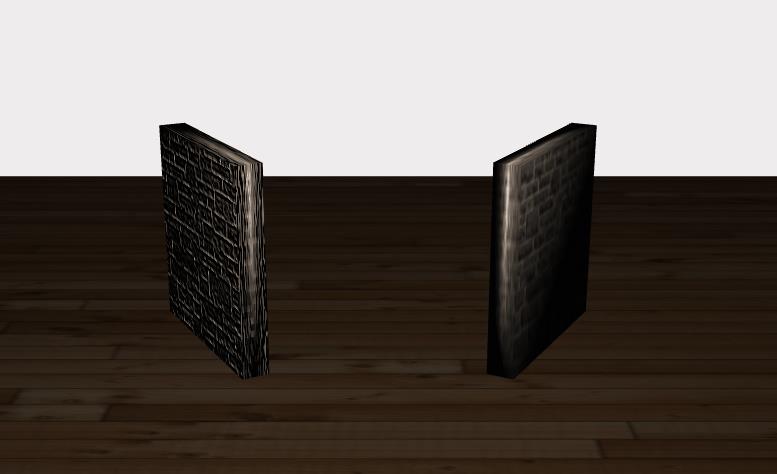使用vue学习three.js之加载和使用纹理-设置material.bumpMap属性使用凹凸贴图创建皱纹
Posted 点燃火柴
tags:
篇首语:本文由小常识网(cha138.com)小编为大家整理,主要介绍了使用vue学习three.js之加载和使用纹理-设置material.bumpMap属性使用凹凸贴图创建皱纹相关的知识,希望对你有一定的参考价值。
1.demo效果

2. 实现要点
2.1 创建地板
createFloor() {
const publicPath = process.env.BASE_URL
const floorTex = new THREE.TextureLoader().load(
`${publicPath}textures/general/floor-wood.jpg`
)
const plane = new THREE.Mesh(
new THREE.BoxGeometry(200, 100, 0.1, 30),
new THREE.MeshPhongMaterial({
color: 0x3c3c3c,
map: floorTex
})
)
plane.position.y = -7.5
plane.rotation.x = -0.5 * Math.PI
this.scene.add(plane)
}
2.2 创建凹凸贴图的物体
通过凹凸贴图可以实现材质表面不同深度的凹凸,使物体更有真实感,实现过程很简单
需要准备两个纹理贴图
一个用来设置material.map 属性,用作材质的普通贴图
一个用来设置material.bumpmap属性,用作材质的凹凸贴图
除此之外要想审查凹凸纹理效果material还有一个bumpScale属性要设置
createMesh(geom, imageFile, bump) {
const publicPath = process.env.BASE_URL
const texture = new THREE.TextureLoader().load(`${publicPath}textures/general/` + imageFile)
geom.computeVertexNormals()
const mat = new THREE.MeshPhongMaterial()
mat.map = texture
if (bump) {
const bump = new THREE.TextureLoader().load(`${publicPath}textures/general/` + bump)
mat.bumpMap = bump
mat.bumpScale = 0.2
}
const mesh = new THREE.Mesh(geom, mat)
return mesh
}
//创建带凹凸贴图的物体
this.cube2 = this.createMesh(
new THREE.BoxGeometry(15, 15, 2),
'stone.jpg',
'stone-bump.jpg'
)
this.cube2.rotation.y = 0.5
this.cube2.position.x = -12
this.scene.add(this.cube2)
2.3 创建普通贴图的物体
//创建没有凹凸贴图的物体
this.cube1 = this.createMesh(
new THREE.BoxGeometry(15, 15, 2),
'stone.jpg'
)
this.cube1.rotation.y = -0.5
this.cube1.position.x = 12
this.scene.add(this.cube1)
3. demo代码
<template>
<div>
<div id="container" />
<div class="controls-box">
<section>
<el-row>
<el-checkbox v-model="properties.rotate">
rotate
</el-checkbox>
</el-row>
<el-row>
<div v-for="(item,key) in properties" :key="key">
<div v-if="item&&item.name!=undefined">
<el-col :span="8">
<span class="vertice-span">{{ item.name }}</span>
</el-col>
<el-col :span="13">
<el-slider v-model="item.value" :min="item.min" :max="item.max" :step="item.step" :format-tooltip="formatTooltip" @change="propertiesChange" />
</el-col>
<el-col :span="3">
<span class="vertice-span">{{ item.value }}</span>
</el-col>
</div>
</div>
</el-row>
<el-row>
<el-col :span="8" class="label-col">
<label>texture</label>
</el-col>
<el-col :span="16">
<el-select v-model="properties.textureType" placeholder="请选择" @change="propertiesChange">
<el-option v-for="item in texturesOptions" :key="item.value" :label="item.label" :value="item.value" />
</el-select>
</el-col>
</el-row>
</section>
</div>
</div>
</template>
<script>
import * as THREE from 'three'
import { OrbitControls } from 'three/examples/jsm/controls/OrbitControls.js'
export default {
data() {
return {
texturesOptions: [
{
value: 'stone',
label: 'stone'
},
{
value: 'weave',
label: 'weave'
}
],
properties: {
bumpScale: {
name: 'bumpScale',
value: 0.2,
min: -2,
max: 2,
step: 0.1
},
textureType: 'stone',
rotate: false
},
cube1: null,
cube2: null,
camera: null,
scene: null,
renderer: null,
controls: null
}
},
mounted() {
this.init()
},
methods: {
formatTooltip(val) {
return val
},
// 初始化
init() {
this.createScene() // 创建场景
this.createModels() // 创建模型
this.createLight() // 创建光源
this.createCamera() // 创建相机
this.createRender() // 创建渲染器
this.createControls() // 创建控件对象
this.render() // 渲染
},
// 创建场景
createScene() {
this.scene = new THREE.Scene()
},
// 创建模型
createModels() {
//创建没有凹凸贴图的物体
this.cube1 = this.createMesh(
new THREE.BoxGeometry(15, 15, 2),
'stone.jpg'
)
this.cube1.rotation.y = -0.5
this.cube1.position.x = 12
this.scene.add(this.cube1)
//创建带凹凸贴图的物体
this.cube2 = this.createMesh(
new THREE.BoxGeometry(15, 15, 2),
'stone.jpg',
'stone-bump.jpg'
)
this.cube2.rotation.y = 0.5
this.cube2.position.x = -12
this.scene.add(this.cube2)
// console.log(this.cube2.geometry.faceVertexUvs)
this.createFloor()
},
createMesh(geom, imageFile, bump) {
const publicPath = process.env.BASE_URL
const texture = new THREE.TextureLoader().load(
`${publicPath}textures/general/` + imageFile
)
geom.computeVertexNormals()
const mat = new THREE.MeshPhongMaterial()
mat.map = texture
if (bump) {
const bump = new THREE.TextureLoader().load(
`${publicPath}textures/general/` + bump
)
mat.bumpMap = bump
mat.bumpScale = 0.2
}
const mesh = new THREE.Mesh(geom, mat)
return mesh
},
createFloor() {
const publicPath = process.env.BASE_URL
const floorTex = new THREE.TextureLoader().load(
`${publicPath}textures/general/floor-wood.jpg`
)
const plane = new THREE.Mesh(
new THREE.BoxGeometry(200, 100, 0.1, 30),
new THREE.MeshPhongMaterial({
color: 0x3c3c3c,
map: floorTex
})
)
plane.position.y = -7.5
plane.rotation.x = -0.5 * Math.PI
this.scene.add(plane)
},
// 创建光源
createLight() {
// 环境光
const ambientLight = new THREE.AmbientLight(0x242424, 0.1) // 创建环境光
this.scene.add(ambientLight) // 将环境光添加到场景
const spotLight = new THREE.SpotLight(0xffffff) // 创建聚光灯
spotLight.position.set(0, 30, 30)
spotLight.intensity = 1.2
this.scene.add(spotLight)
},
// 创建相机
createCamera() {
const element = document.getElementById('container')
const width = element.clientWidth // 窗口宽度
const height = element.clientHeight // 窗口高度
const k = width / height // 窗口宽高比
// PerspectiveCamera( fov, aspect, near, far )
this.camera = new THREE.PerspectiveCamera(45, k, 0.1, 1000)
this.camera.position.set(0, 12, 38) // 设置相机位置
this.camera.lookAt(new THREE.Vector3(0, 0, 0)) // 设置相机方向
this.scene.add(this.camera)
},
// 创建渲染器
createRender() {
const element = document.getElementById('container')
this.renderer = new THREE.WebGLRenderer({ antialias: true, alpha: true })
this.renderer.setSize(element.clientWidth, element.clientHeight) // 设置渲染区域尺寸
// this.renderer.shadowMap.enabled = true // 显示阴影
// this.renderer.shadowMap.type = THREE.PCFSoftShadowMap
this.renderer.setClearColor(0xeeeeee, 1) // 设置背景颜色
element.appendChild(this.renderer.domElement)
},
propertiesChange() {
const publicPath = process.env.BASE_URL
const texture = new THREE.TextureLoader().load(
`${publicPath}textures/general/` + this.properties.textureType + '.jpg'
)
this.cube1.material.map = texture
this.cube2.material.map = texture
const bump = new THREE.TextureLoader().load(
`${publicPath}textures/general/` +
this.properties.textureType +
'-bump.jpg'
)
this.cube2.material.bumpMap = bump
this.cube2.material.bumpScale = this.properties.bumpScale.value
},
updateRotation() {
if (this.properties.rotate) {
this.cube1.rotation.y += 0.01
this.cube2.rotation.y -= 0.01
}
},
render() {
this.updateRotation()
this.renderer.render(this.scene, this.camera)
requestAnimationFrame(this.render)
},
// 创建控件对象
createControls() {
this.controls = new OrbitControls(this.camera, this.renderer.domElement)
}
}
}
</script>
<style>
#container {
position: absolute;
width: 100%;
height: 100%;
}
.controls-box {
position: absolute;
right: 5px;
top: 5px;
width: 300px;
padding: 10px;
background-color: #fff;
border: 1px solid #c3c3c3;
}
.label-col {
padding: 8px 5px;
}
.vertice-span {
line-height: 38px;
padding: 0 2px 0 10px;
}
</style>
以上是关于使用vue学习three.js之加载和使用纹理-设置material.bumpMap属性使用凹凸贴图创建皱纹的主要内容,如果未能解决你的问题,请参考以下文章